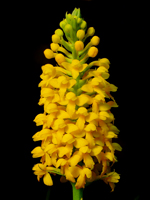Orange Fringeless Orchid (Platanthera integra)
Part of the Florida's Native and Naturalized Orchids Website
Classification:Kingdom: Plantae - Plants
Subkingdom: Tracheobionta - Vascular Plants
Superdivision: Spermatophyta - Seed plants
Division: Magnoliophyta - Flowering plants
Class: Liliopsida - Monocotyledons
Subclass: Liliidae - Lily/related subclass
Order: Orchidales - Orchid order
Family: Orchidaceae - Orchid Family
Subfamily: Orchidiodeae -
Tribe: Orchideae - Orchidoids.
Subtribe: Orchidinae - Orchis and related.
|
Distribution Map: |
Description: Synonyms: Orchis integra Nutt., Gen. N. Amer. Pl. 2: 188 (1818).; Habenaria integra (Nutt.) Spreng., Syst. Veg. 3: 689 (1826).; Gymnadeniopsis integra (Nutt.) Rydb. in N.L.Britton, Man. Fl. N. States: 293 (1901). Summary: Medium-sized terrestrial orchids to 18 inches (45.7 cm) tall bearing a flower head 3 inches (7.5 cm) or smaller in height. Flowers yellow to orange, compact, bearing a spur-like nectary and entire lips with slight crenulation on the margins. Common Name: Orange Fringeless Orchid Habitat: Moist, open pinelands, wet prairies, wet roadsides and ditches. Flowering season: July through September (peaking in August) |
Images:
Description:
Late summer is the time when these stately little orchids emerge from the surrounding grasses and show off their deep gold colored flower heads. The small (1 cm) flowers with slightly lacerated edges (but not the deep fringing seen in other Platantheras) are packed in a very dense cluster atop a fluted, blue-green stem. The leaves start out rather long for the small plants at the base of the plants, but are quickly reduced to the size of the floral bracts somewhat below the actual flower head.
Although small, they are quite conspicuous. Perhaps the best time to look for these is in the late afternoon, when the sunlight itself is golden. If it happens to catch the flowers of one of these orchids, you would be convinced that small torches had been lit within the bog.
These plants are found most commonly in the western Panhandle of Florida, but are still never very common. Occasionally, they will form rather dense colonies in areas where conditions are favorable for their growth and reproduction.
I recall one time fossil hunting in the late summer in an area of south-central Alabama. I had come across a particular roadcut/hillside that seemed to have a promising looking sedimentary rock deposit. It was decidedly wet from some sort of spring/seepage at the top of the slope. As I was poking around at the bottom of this hill, my eyes suddenly met one of these lovely orchids growing at face-level out of a crevice in the rock. As I gazed up the hillside, several hundred of these beauties could be seen glowing in the late afternoon sun. It was a sight that took my breath away, and one that I almost had missed because my focus was set on hunting another type of prize that day.
Copyright © 2009-2020 Prem Subrahmanyam, All Rights Reserved.
No Text or Images from this web site may be used, in whole or in part, without the express permission of the author.
For further information, see the Terms of Use page.






